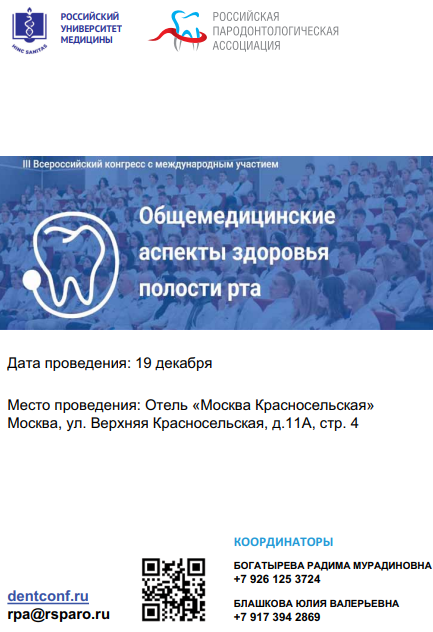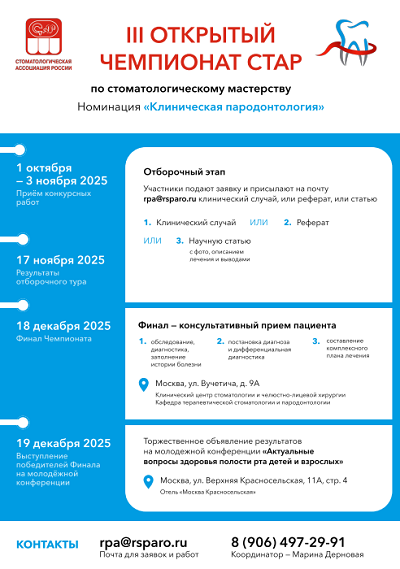The role of oral fluid biological markers in the clinical course of lichen planus
https://doi.org/10.33925/1683-3759-2021-26-3-203-209
Abstract
Relevance. The pathogenetic mechanisms, which initiate oral mucosa cancer in patients with lichen planus, have not been entirely studied yet. However, endogenous factors, including matrix metalloproteinases (MMP), can be crucial in malignization. The study aimed to analyze the levels of MMP-8, tissue inhibitor of matrix metalloproteinase (TIMP)-1 and MMP-8/TIMP-1 ratio in the oral fluid of patients with various forms of lichen planus.
Materials and methods. We examined and treated 24 women, aged 35-70 years old, with reticular (14 patients) and atrophic (10 patients) oral lichen planus. The study determined the concentration of biological markers MMP-8 and TIMP-1 in the oral fluid before and after the treatment. The local treatment consisted of anti-inflammatory therapy with antiseptic solutions as oral baths with an exposure of 1 minute, application of vitamin A and E oil solutions on the gauze for 15-20 minutes, immune-corrective therapy was applied. We followed up with the patients at the diagnostic stage, after 14 days of treatment and 3 months later.
Results. The study revealed statistically significant differences in the ratio of MMP-8 and TIMP-1 levels in the oral fluid of lichen planus patients compared to the controls (p = 0.006). 11 patients exhibited an increase of MMP-8/TIMP-1 ratio in comparison with the ratio maximum in control (p = 0.006).
Conclusion. To assess the course of the disease in patients with various forms of oral lichen planus, the clinicians should evaluate the concentration ratio of biological markers MMP-8/ TIMP-1 in the mixed saliva. Clinicians should monitor the changes in the level of MMP-8/TIMP-1 in the oral fluid at least once every three months.
About the Authors
E. A. GorbatovaRussian Federation
Ekaterina A. Gorbatova, MD, PhD, Associate Professor, Department of Dentistry
Moscow
M. V. Kozlova
Russian Federation
Marina V. Kozlova, MD, PhD, DSc, Professor, Head of the Department of Dentistry
Moscow
N. E. Kushlinsky
Russian Federation
Nikolay E. Kushlinsky, MD, PhD, DSc, Professor, Academician of the Russian Academy of Sciences, Head of the Laboratory of Clinical Biochemistry
Moscow
E. S. Gerstein
Russian Federation
Elena S. Gerstein, MD, PhD, DSc, Professor, Leading Researcher, Laboratory of Clinical Biochemistry
Moscow
References
1. Agha-Hosseini F, Khalili M, Rohani B. Immunohistochemistry analysis of P53 and Ki-67 proteins in oral lichen planus and normal oral mucosa. Iranian Journal of Public health. 2009;38(2):37-43. Available from: https://ijph.tums.ac.ir/index.php/ijph/article/view/3187
2. Agha-Hosseini F, Moslemi E, Mirzaii-Dizgah I. Comparative evaluation of low-level laser and CO₂ laser in treatment of patients with oral lichen planus. International Journal of oral and Maxillofacial Surgery. 2012;41(10):1265-1269. doi: 10.1016/j.ijom.2012.06.001
3. Fitzpatrick SG, Hirsch SA, Gordon SC. The malignant transformation of oral lichen planus and oral lichenoid lesions: a systematic review. Journal of the american dental association. 2014;145(1):45-56. doi: 10.14219/jada.2013.10
4. Giacomelli L, Oluwadara O, Chiappe G, Barone A, Chiappelli F, Covani U. Relationship between human oral lichen planus and oral squamous cell carcinoma at a genomic level: a datamining study. Bioinformation. 2009;4(6):258-262. doi: 10.6026/97320630004258
5. Alaizari NA, Al-Maweri SA, Al-Shamiri HM, Tarakji B, Shugaa-Addin B. Hepatitis C virus infections in oral lichen planus: a systematic review and meta-analysis. australian dental Journal. 2016;61(3):282-287. doi: 10.1111/adj.12382
6. Sugerman PB, Savage NW, Walsh LJ, Zhao ZZ, Zhou XJ, Khan A, Seymour GJ, Bigby M. The pathogenesis of oral lichen planus. critical reviews in oral Biology and Medicine: an official publication of the american association of oral Biologists. 2002;13(4):350-365. doi: 10.1177/154411130201300405
7. Agha-Hosseini F, Borhan-Mojabi K, Monsef-Esfahani HR, Mirzaii-Dizgah I, Etemad-Moghadam S, Karagah A. Efficacy of purslane in the treatment of oral lichen planus. Phytotherapy research: PTr. 2010;24(2):240-244. doi: 10.1002/ptr.2919
8. Sargeran K, Murtomaa H, Safavi SM, Vehkalahti M, Teronen O. Malignant oral tumors in iran: ten-year analysis on patient and tumor characteristics of 1042 patients in Tehran. The Journal of craniofacial Surgery. 2006;17(6):1230-1233. doi: 10.1097/01.scs.0000246728.23483.ce
9. Gershtein ES, Kushlinskii NE. Clinical prospects of tumor-associated proteases and their tissue inhibitors investigation in oncologic patient. Bulletin of the russian academy of Medical Sciences. 2013;(5):16-27. (In Russ.). doi: 10.15690/vramn.v68i5.659
10. Sorsa T, Tjäderhane L, Salo T. Matrix metalloproteinases (MMPs) in oral diseases. oral diseases. 2004;10(6):311-318. doi: 10.1111/j.1601-0825.2004.01038.x
11. Venugopal A, Uma Maheswari TN. Expression of matrix metalloproteinase-9 in oral potentially malignant disorders: A systematic review. Journal of oral and Maxillofacial Pathology. 2016;20(3):474-479. doi: 10.4103/0973-029X.190951
12. Nwomeh BC, Liang HX, Cohen IK, Yager DR. MMP-8 is the predominant collagenase in healing wounds and nonhealing ulcers. The Journal of Surgical research. 1999;81(2):189-195. doi: 10.1006/jsre.1998.5495
13. Kushlinskii NE, Solovykh EA, Karaoglanova TB, Bayar U, Gershtein ES, Troshin AA, Kostyleva OI, Grinin VM, Maksimovskaya LN, Yanushevitch OO. Content of matrix metalloproteinase-8 and matrix metalloproteinase-9 in oral fluid of patients with chronic generalized periodontitis. Bulletin of еxperimental Biology and Medicine. 2011;152(2):240-244. doi: 10.1007/s10517-011-1498-2
14. Grünwald B, Schoeps B, Krüger A. Recognizing the Molecular Multifunctionality and Interactome of TIMP-1. Trends in Сell Biology. 2019;29(1):6-19. doi: 10.1016/j.tcb.2018.08.006
15. Ries C. Cytokine functions of TIMP-1. cellular and Molecular life Sciences. 2014;71(4):659-672. doi: 10.1007/s00018-013-1457-3
16. Böckelman C, Beilmann-Lehtonen I, Kaprio T, Koskensalo S, Tervahartiala T, Mustonen H, Stenman UH, Sorsa T, Haglund C. Serum MMP-8 and TIMP-1 predict prognosis in colorectal cancer. BMc cancer. 2018;18(1):679. doi: 10.1186/s12885-018-4589-x
17. Gutiérrez-Corrales A, Campano-Cuevas E, CastilloDalí G, Torres-Lagares D, Gutiérrez-Pérez JL. Ability of salivary biomarkers in the prognostic of systemic and buccal inflammation. Journal of clinical and experimental dentistry. 2017;9(5):e716-e722. doi: 10.4317/jced.53776
18. G D, Nandan SRK, Kulkarni PG. Salivary Tumour Necrosis Factor-α as a Biomarker in Oral Leukoplakia and Oral Squamous Cell Carcinoma. asian Pacific Journal of cancer Prevention. 2019;20(7):2087-2093. doi: 10.31557/APJCP.2019.20.7.2087
19. Wu JY, Yi C, Chung HR, Wang DJ, Chang WC, Lee SY, Lin CT, Yang YC, Yang WC. Potential biomarkers in saliva for oral squamous cell carcinoma. oral oncology. 2010;46(4):226-231. doi: 10.1016/j.oraloncology.2010.01.007
20. Hema Shree K, Ramani P, Sherlin H, Sukumaran G, Jeyaraj G, Don KR, Santhanam A, Ramasubramanian A, Sundar R. Saliva as a diagnostic tool in oral squamous cell carcinoma – a systematic review with meta analysis. Pathology oncology research. 2019;25(2):447-453. doi: 10.1007/s12253-019-00588-2
21. Guseva AV. Comparative evaluation of methods of treatment of patients with severe forms of lichen planus. Stomatologiya. 2016;(3):67-68. (In Russ.). Available from: https://www.mediasphera.ru/issues/stomatologiya/2016/3/
Review
For citations:
Gorbatova EA, Kozlova MV, Kushlinsky NE, Gerstein ES. The role of oral fluid biological markers in the clinical course of lichen planus. Parodontologiya. 2021;26(3):203-209. (In Russ.) https://doi.org/10.33925/1683-3759-2021-26-3-203-209




































